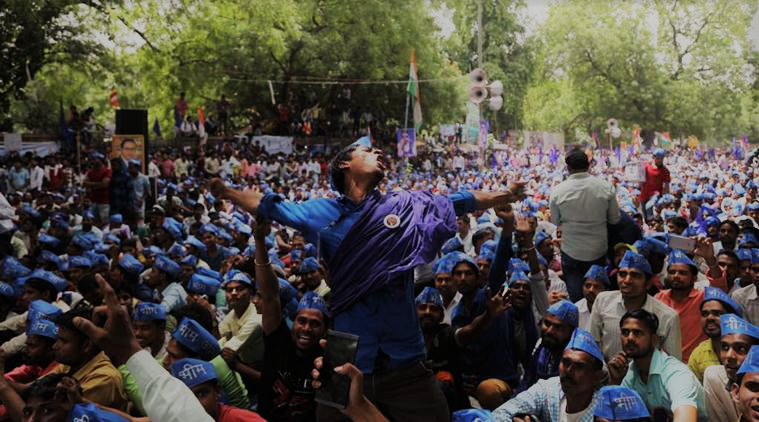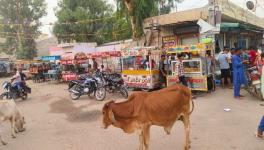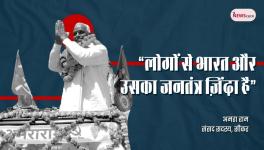Assembly Verdict: BJP Loses SC/ST and Urban Voters

In Madhya Pradesh, Rajasthan and Chhattisgarh, the Bharatiya Janata Party (BJP) has heavily lost in seats reserved for Dalits and Adivasis, indicating a dramatic change from the 2013 Assembly elections. What is even more striking is that it has lost ground in urban and semi-urban seats, too, in all three states, clearly showing that even its traditional base in the urban middle class is fast eroding. This also shows that the BJP’s communal propaganda is unable to attract voters in these sections that had earlier been influenced by such tactics.
Data used in the following sections is derived from Election Commission through the Election Data Analysis tool specially designed and made available in public domain by Newsclick here.
Dalit & Adivasi Anger
In MP, the BJP had won as many as 59 of the 82 reserved seats in 2013. But in the recently held Assembly elections, its tally in these seats plummeted to just 34 – a loss of 25 seats. BJP’s vote share went down by over 4% in these seats. In Rajasthan, the BJP’s tally in the state’s 59 reserved seats dipped from a whopping 50 in 2013 to just 21 this time. That’s a loss of 29 seats and a vote swing of nearly 6%. In the predominantly tribal state of Chhattisgarh, the BJP’s tally in the 39 reserved seats went from 20 last time to 5 this time, while its vote share crashed by over 8%.
Why this serious erosion in Dalit and Adivasi support? BJP’s connivance in the dilution of the SC/ST Prevention of Atrocities Act (POA) by the Supreme Court and its dilly-dallying in bringing in an over-riding legal remedy was the most immediate cause. But this was preceded by a growing suspicion among Dalits and Adivasis that the BJP and the larger Sangh Parivar were unleashing a war against them, as evidenced in the growing number of atrocities, attacks in the name of cow protection, non-implementation of the Forest Rights Act (FRA), cuts in special budgetary allocations for these communities, etc.
Since the BJP’s attempts to win back support from these sections consisted of such transparently trivial and condescending acts, such as asking its MPs to have a meal or spend a night with a Dalit family and such other stunts, the alienation is likely to persist and grow. In which case, this will find reflection in next year’s general elections too.
Urban & Semi-urban Alienation
Another fall-out of the Modi government’s policies was that in these three states, urban and semi-urban voters showed increasing disaffection with BJP. This is an unexpected phenomenon because the urban areas with a significant middle class was always seen as supportive of the BJP brand of neo-liberal economic policies (like privatisation) as also of its communal ideology. But the Assembly election results show that this citadel is crumbling.
In MP, BJP had swept 20 of the 22 urban seats in 2013. This tally nearly halved as it lost 9 of these seats. Its urban vote share went down by as much as 6%. In Rajasthan, too, BJP had swept the urban areas winning 18 of the 19 seats in 2013, but this time round, it lost 8 of these seats while its vote share declined by a stunning 9%. In Chhattisgarh, of the 8 urban seats, BJP had won 6 in 2013, but it lost four of them this time, with over 6% votes also shifting away.
In semi-urban areas, the story is similar though not exactly the same. In Chhattisgarh, with total 19 semi-urban seats, BJP lost 5 seats, down from 12 in 2013 to seven this time, and its vote share dipped by nearly 7%. This is roughly comparable to the loss of votes it suffered in urban seats. But in Rajasthan, with 25 semi-urban seats, the BJP suffered a major decline losing 13 of the 19 seats it had held in 2013. In MP, there are 23 semi-urban seats, of which BJP held 18 in 2013. It lost 5 of these in 2018, and its vote share declined by about 5%.
Clearly, in the semi-urban segments, BJP’s losses are uneven, with Chhattisgarh exhibiting the highest loss in terms of vote share, although in terms of seats, MP and Rajasthan show lower disaffection. This could be because of the larger rural influence in Chhattisgarh’s semi-urban seats.
Whatever be the case, the losses of BJP in urban areas are much more than in semi-urban or even rural areas in Rajasthan and MP. This is probably attributable to the effect of the twin disasters of demonetisation and the Goods and Services Tax (GST), which had a much more long-range impact on traders and small businesses.
The decline in Dalit/Adivasi votes, as well as in urban/semi-urban areas, also indicates that the communal card – best epitomised by BJP’s chief campaigner Yogi Adityanath – is not working in these sections of voters. Real life issues – atrocities, discrimination, notebandi, GST – are the real issues, not some promised Ram Temple.
Get the latest reports & analysis with people's perspective on Protests, movements & deep analytical videos, discussions of the current affairs in your Telegram app. Subscribe to NewsClick's Telegram channel & get Real-Time updates on stories, as they get published on our website.
























